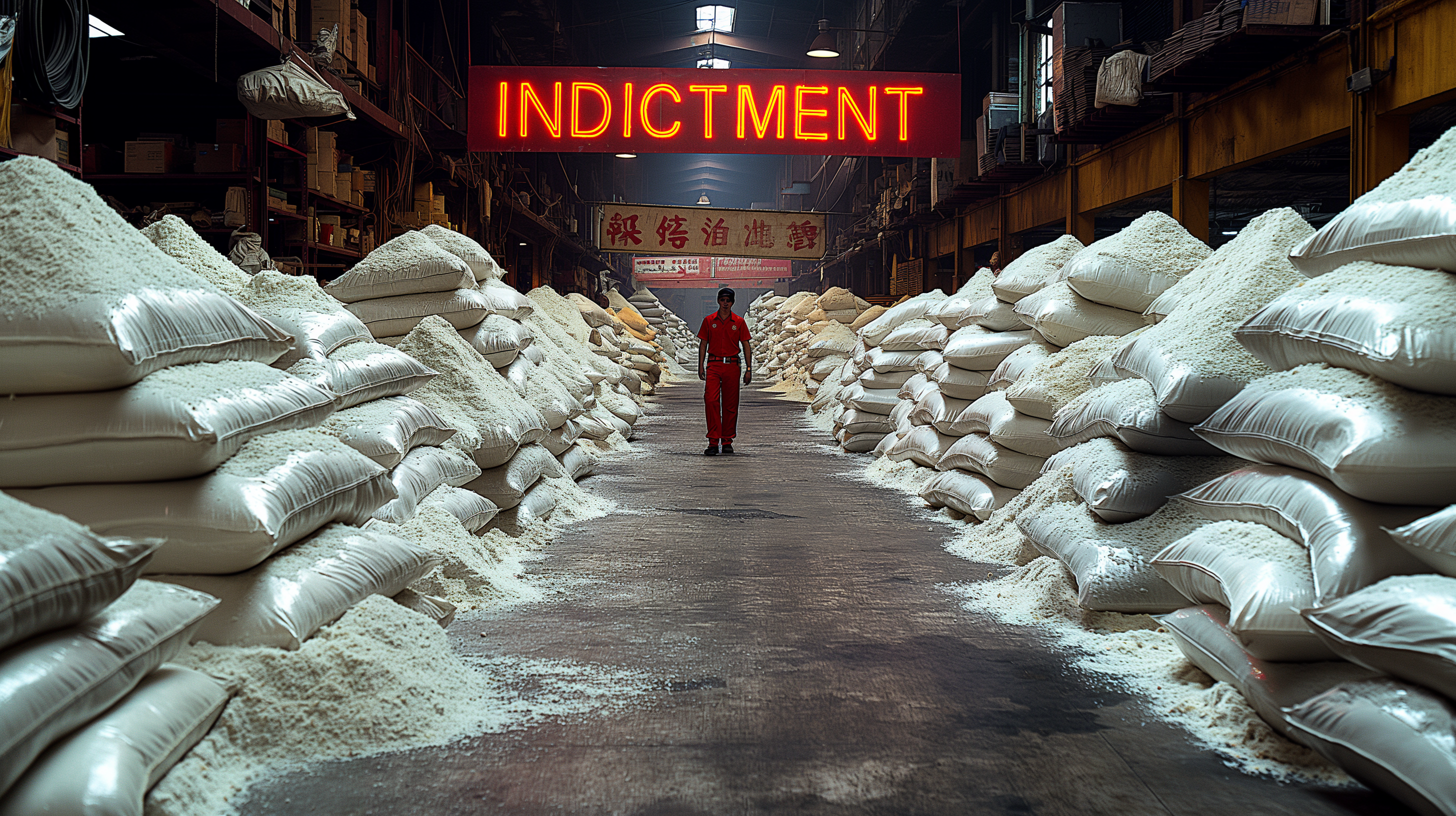
Federal authorities cracked down on a massive money laundering operation involving a surprising alliance between Mexican drug cartels and Chinese criminal organizations. The multi-million dollar scheme utilized sophisticated tactics to launder drug proceeds across international borders.
by LawInc Staff
June 18, 2024
A major indictment unsealed in Los Angeles federal court is shining a light on an alleged sophisticated scheme between Mexico’s powerful Sinaloa drug cartel and Chinese money laundering organizations operating in the U.S. The charges detail a complex conspiracy to distribute massive amounts of narcotics and launder the proceeds through trade and underground banking.
This guide provides an in-depth legal perspective on all 10 counts against the 24 defendants, the key facts, money laundering mechanisms, and potential ramifications of this international criminal case code-named “Operation Fortune Runner.” From alleged bulk cash pickups by the cartel to laundering through Chinese businesses, gain insight into how the operation worked and the laws at issue.
Whether you’re fascinated by cartel operations, white collar crime, or curious about the charges, this comprehensive breakdown has you covered. Dig into the details and educate yourself on this landmark case at the intersection of narco trafficking and global money laundering.
1. Overview of the Sinaloa Cartel Indictment
-
- 24 Defendants Across Multiple Conspiracies: Charges two dozen individuals, many with aliases, as part of parallel drug trafficking, money laundering, and unlicensed money transmitting business schemes.
- 10 Counts Including Conspiracy, Drug & Money Laundering Offenses: Alleges a sophisticated alliance between the Sinaloa Cartel and Chinese money laundering groups to distribute narcotics and clean the proceeds.
- Sinaloa Cartel & Chinese Money Brokers: Involves collaboration between the powerful Mexico-based cartel and Chinese nationals seeking to avoid currency controls.
- Bulk Cash Pickups & Laundering Methods: Describes how millions in drug cash was collected across the U.S. and laundered via various techniques back to cartel leadership.
- Serious Charges With Hefty Sentences: Defendants face potential decades in federal prison if convicted, plus criminal forfeiture of tainted assets.
Results of “Operation Fortune Runner”
-
- Approximately $5 million in drug money seized, along with 302 lbs cocaine, 92 lbs meth, other drugs/guns.
- Recent arrests of fugitive defendants in Mexico and China who fled initial U.S. charges last year.
- DEA Administrator: Exposing alliance between Sinaloa Cartel and Chinese money launderers in LA and China.
- U.S. Attorney: Crucial to target transnational syndicates that wash profits to cripple cartels and protect the public.
- Case designated an Organized Crime Drug Enforcement Task Forces (OCDETF) operation leveraging multi-agency cooperation.
At a Glance: The 10 Counts
- Count 1: Conspiracy to Aid and Abet Distribution of Cocaine and Meth
- Count 2: Conspiracy to Launder Money
- Counts 3-6: Possession with Intent to Distribute Cocaine and Meth
- Count 7: Conspiracy to Operate an Unlicensed Money Transmitting Business
- Counts 8-9: Structuring Transactions to Avoid Reporting Requirements
- Count 10: Assaulting a Federal Officer
FAQs:
-
- Who are considered the lead defendants? The indictment points to one person as a primary liaison between the cartel and Chinese money laundering organizations, and several others as key leaders on the Chinese side.
- What are the potential sentences? Many counts carry 10-life in prison; money laundering up to 20 years. Depends on criminal history, drug quantities, roles, enhancements.
- How long was the conspiracy? Alleged to span from Oct 2019 to Oct 2023, with dozens of overt acts in California and elsewhere.
- Will assets be seized? The government gave notice it will seek forfeiture of any property derived from or used to facilitate the crimes.
- What happens next? Defendants will be arraigned on the charges, file any motions, enter pleas and then likely face a jury trial unless they enter plea agreements. It’s a complex case that could take years to reach a conclusion.
2. The Sinaloa Cartel & Chinese Money Laundering Orgs
-
- The Sinaloa Cartel: Based in Mexico, one of the largest, most powerful drug trafficking organizations in the world. Allegedly responsible for importing massive amounts of fentanyl into the U.S.
- Chinese Money Laundering Groups: Allegedly partnered with the cartel to pick up bulk drug cash across the U.S., launder and remit it back to Mexico, taking a small commission.
- Demand for U.S. Dollars in China: Chinese organizations have high demand to convert money out of the U.S. to China to skirt foreign exchange restrictions.
- Black Market Peso Exchange: An informal value transfer system used to launder dollars from U.S. drug sales via trade-based methods like buying goods for export.
- Underground Banking: Chinese “informal value transfer systems” move funds between the U.S. and China as part of the alleged scheme to launder cartel money.
Key Facts About the Sinaloa Cartel & Chinese MLOs
-
- Sinaloa cartel distributes fentanyl, cocaine, meth, heroin around the world, fueling U.S. addiction crisis, per DOJ.
- Lead defendant allegedly traveled to Mexico to meet cartel and secure money laundering contracts for a % fee.
- Chinese MLOs charged small commissions (0.5-2%) to launder big volume, vs. traditional methods charging 5-10% or more.
- Launderers allegedly used bank accounts in alias names and shell company names to conceal true source of funds.
- Bulk cash pickups arranged nationwide, laundered via complex schemes to send value back to cartel in Mexico.
The Alleged Scheme
- Drug traffickers contract with Chinese MLOs for cash pickups and laundering services for a small commission fee.
- MLO representatives collect bulk U.S. cash from traffickers nationwide, confirm receipt to release equivalent funds to cartel in Mexico.
- MLOs layer funds through trade-based schemes like buying/exporting goods to Mexico or through informal Chinese banking systems to transfer value.
- Cash used to satisfy demand for U.S. currency by Chinese nationals trying to move money out of China; avoids restrictions and reporting.
- Cartel reaps drug proceeds back in Mexico, Chinese nationals get U.S. dollars, and MLOs take a cut, per the allegations.
FAQs:
-
- How much money was allegedly laundered? The indictment alleges 10s to 100s of millions over the conspiracy but no precise figure. It lists dozens of seizures of $100k-$600k at a time from defendants.
- How were the MLOs paid? A commission structure where the networks kept 0.5-2% of the amount laundered as their fee from the cartel.
- Why did the cartel use the Chinese MLOs? They allegedly offered more sophisticated, efficient laundering services for a lower price than traditional money brokers.
- Is this the first case of its kind? No, US authorities have been warning of trade-based money laundering and Chinese MLOs working with drug traffickers for years, but this case is especially large and far-reaching.
3. The Case Against the Sinaloa Cartel
-
- Importing Massive Amounts of Drugs: Feds allege the cartel brought huge loads of cocaine, meth, heroin, fentanyl into the U.S. for distribution.
- Fueling the Opioid Crisis: Sinaloa called “largely responsible” for the influx of fentanyl ravaging American communities in recent years.
- Generating Huge Cash Proceeds: The cartel’s U.S. drug sales yielded massive sums of bulk cash that needed laundering back to Mexico.
- Conspiracy to Aid Drug Distribution: Count 1 charges a conspiracy to aid and abet distribution of narcotics via the money laundering.
- Cartel Meeting to Arrange Laundering: A lead defendant allegedly traveled to Mexico to meet cartel brass and secure contracts with Chinese money remitters.
The Sinaloa Cartel’s Alleged U.S. Distribution
-
- Evidence suggests the cartel imported cocaine, meth, heroin, fentanyl and more into the U.S. for widespread distribution.
- Cartel associates allegedly delivered shipments to a network of local dealers and criminal groups to sell at the retail level.
- The DOJ called Sinaloa a key driver of the fentanyl epidemic, linking the synthetic opioid to escalating overdoses nationwide.
- Several defendants allegedly distributed cartel cocaine and meth, then funneled proceeds to launderers.
- Cash pickups occurred frequently in parking lots, homes, and businesses across California, per the overt acts.
How the Scheme Allegedly Worked
- Cartel operatives notified U.S. contacts of incoming bulk drug cash to collect and amount/location.
- U.S. reps picked up cash, counted it and remitted it to Chinese MLOs for processing and transfer back to cartel.
- Various laundering techniques used like buying goods in China for export to Mexico, informal value transfer, buying cryptocurrencies.
- Once cartel confirmed receipt of funds from Chinese MLOs (minus fee), the laundering cycle was complete.
- Cartel could continue importing/selling more drugs, generating dirty cash, and repeat cycle with help of the MLOs.
FAQs:
-
- What are the potential sentences for the drug charges? 10 years to life in prison for the conspiracy and substantive drug distribution counts.
- How did the cartel collect so much cash? Allegedly by importing huge quantities of drugs that were sold at the retail level by dealers and criminal networks.
- Why did the cartel need to launder money? They couldn’t directly deposit millions in drug cash without drawing attention, so they needed to conceal its source and ownership.
- Will cartel leaders in Mexico be prosecuted? The indictment doesn’t charge anyone outside the U.S. but notes that defendants met with cartel brass in Mexico about the scheme. Extradition is always a possibility.
- How strong is the evidence? Based on the detailed overt acts, cash seizures, surveillance and more cited in the indictment, the government seems to have built a substantial case. But every defendant is presumed innocent until proven guilty.
4. The Money Laundering Conspiracy
-
- The Agreement: Chinese MLOs allegedly partnered with Sinaloa cartel to launder drug cash for a commission fee.
- Bulk Cash Collections: MLO reps picked up $100,000s in cartel drug money at a time from dealers nationwide.
- Laundering Methods: Money cleaned via trade-based schemes like buying Chinese goods for export, informal value transfer systems, mirror transactions.
- Shell Companies & Accounts: Illicit funds moved through network of accounts in alias names and front companies to hide money trail.
- Promotion & Concealment Money Laundering: Transactions aimed to both promote the drug trade and conceal the proceeds.
Elements of Money Laundering Conspiracy
- Agreement: 2 or more people agreed to violate federal money laundering laws.
- Knowledge & Intent: Defendants joined the agreement knowing its unlawful purpose and intending to further it.
- Transactions over $10,000: Defendants must have conspired to conduct financial transactions over $10,000 involving criminal proceeds.
- Promotion or Concealment: Transactions aimed to either promote the criminal activity or conceal/disguise the funds’ source, location, ownership.
- Overt Act: At least one conspirator committed an overt act in furtherance of the money laundering agreement.
Notable Overt Acts in the Conspiracy
- Dec 2021: An alleged courier picked up ~$379,660 drug cash that was seized, per overt act 28.
- May 2022: A defendant possessed ~$150,000 suspected drug money in a white plastic bag, per overt act 42.
- Feb 2022: A lead defendant delivered $124,800 to a co-conspirator to buy cryptocurrency for cartel, per overt act 30.
- May 2021: An alleged courier picked up ~$183,030 in bulk cash from an unknown co-conspirator, per overt act 16.
- Aug 2021: A defendant delivered ~$249,500 drug proceeds to a co-defendant, per overt act 25.
FAQs:
-
- What’s the potential sentence for money laundering conspiracy? Up to 20 years in federal prison, plus forfeiture of criminally-derived property.
- Does each defendant have to commit an overt act? No, only one member of the conspiracy has to take an overt step in furtherance of the scheme.
- Do prosecutors have to trace every dollar laundered? Not necessarily. The law allows proving the $10,000 minimum through evidence and inference.
- Can you give examples of the 2 types of money laundering charged? Promotion is using the funds to keep the criminal scheme going; concealment is hiding the nature/source of the money.
- What defenses could apply? Defendants may argue no knowledge the money was dirty, no intent to promote a crime or hide funds, the transactions fell short of the $10k minimum, or attack the conspiracy charge for lack of agreement or an overt act.
5. The Unlicensed Money Transmitting Conspiracy
-
- Operating Without a License: The 24 defendants allegedly conspired to run an unlicensed money transmitting business, a federal crime.
- FinCEN Registration Required: Money transmitters must register with FinCEN, the Financial Crimes Enforcement Network.
- No FinCEN Registration: None of the defendants nor their alleged Money Services Businesses (MSBs) were registered with FinCEN.
- Transferring Illicit Funds: The defendants allegedly transmitted money known to be drug proceeds intended to promote unlawful activity.
- Penalties Include Prison & Fines: The charge carries up to 5 years in prison and hefty fines.
Elements of 18 USC 1960 Violation
- Money Transmitting Business: Defendants operated a business engaged in transferring funds for a fee.
- Interstate or Foreign Commerce: The business affected interstate or foreign commerce.
- Licensing Requirements: Federal law requires such businesses to be registered with FinCEN; CA law requires licensing too.
- Knowing Failure to Comply: Defendants knew of the federal/state licensing mandates but intentionally failed to comply.
- Unlawful Proceeds: The business transferred over $10,000 known to be criminally derived and intended to promote unlawful activity.
The Alleged Scheme
- The Chinese MLO defendants picked up millions in bulk cash drug proceeds from cartel associates across the U.S.
- They allegedly transferred the money to cartel leadership in Mexico through various trade-based and informal value transfer techniques.
- This money transmitting activity crossed state and national borders, affecting interstate and foreign commerce.
- Despite knowing of the licensing rules, none of the 24 defendants nor their purported MSBs had FinCEN registration or state licensure.
- The indictment alleges they conspired to intentionally operate an unlicensed money transmitting business transferring illicit proceeds.
FAQs:
-
- What money transmitting activity is covered? Transferring funds as a business by any means – wire, check, draft, crypto, courier, informal value transfer, etc.
- Who has to register with FinCEN? Any business engaging in money transmission as defined by law, with limited exceptions.
- Are there state laws too? Yes, most states including California require money transmitters to obtain a state license as well.
- What if they didn’t know the law? Ignorance of the law is generally not a defense. Prosecutors must prove defendants knew of the registration mandate but intentionally failed to comply.
- What about the $10,000 minimum? To convict under 1960(b)(1)(C), the government must prove the business transferred over $10k known to be illicit and intended to promote crime.
6. The Structuring Charges
-
- Avoiding a Reporting Requirement: Two defendants allegedly “structured” cash deposits to evade federal reporting rules.
- Deposits Under $10,000: Each made 15-24 separate deposits under the $10,000 threshold into their own accounts on the same day.
- Purpose to Evade Bank Secrecy Act: The apparent purpose was to avoid triggering banks’ obligation to report cash transactions over $10k.
- Felony Due to Dollar Amount: The structured funds totaled $15,960 and $19,900 respectively, making it punishable as a felony.
- Pattern of Unlawful Activity: The indictment alleges the structuring was part of a pattern of illegal activity involving over $100k in a 12-month period.
Elements of Unlawful Structuring
- $10,000 Reporting Threshold: Law requires financial institutions to report cash transactions over $10,000 to the government.
- Structured to Evade: Defendant structured or assisted in structuring transactions, like deposits under $10,000, to evade the reporting requirement.
- Knowledge & Intent: Defendant knew of the law and structured with intent to evade, not for a legitimate business purpose.
- While Violating Another Law: The structuring occurred while violating another federal law (like money laundering) or as part of a pattern of illegal activity over $100k.
The Alleged Transactions
- Jan 27, 2021: One defendant made 24 separate deposits under $10k totaling $15,960 at LA-area Citi ATMs within 75 minutes.
- Jan 29, 2021: Another defendant made 15 separate deposits under $10k totaling $19,900 at Long Beach Citi ATM in 13 minutes.
- All deposits were to accounts each defendant controlled and occurred in a single day across multiple locations.
- Indictment alleges this was to evade the $10k cash reporting requirement while laundering drug proceeds, constituting a felony.
- Pattern of unlawful activity involving over $100k also alleged, which enhances the penalties if proven.
FAQs:
-
- What’s the purpose of the reporting law? To help the government identify large cash transactions that could be related to crimes like money laundering, tax evasion or drugs.
- Is structuring always illegal? No, only if done with intent to evade the law, while violating another law, or as part of a pattern exceeding $100k.
- What are the potential penalties? Up to 5 years prison and $250k fine for each count, or up to 10 years if part of a pattern over $100k.
- What if the cash was legitimate? The law still prohibits structuring to evade reporting even if the money is from a legal source. The extra elements make it a felony.
- How can they prove intent to evade? Evidence like amount and frequency of deposits, using different branches, and doing it just under the $10k threshold can infer intent. Harder to claim an innocent purpose.
7. Assaulting a Federal Officer
-
- Defendant Charged With Assault: Count 10 accuses an alleged courier of forcibly assaulting a DEA Task Force Officer (TFO).
- Allegedly Used Deadly Weapon: Defendant allegedly used his car to assault the TFO when the TFO tried to detain him.
- TFO Was on Official Duty: The alleged assault occurred while the TFO was engaged in official duties as part of a DEA investigation.
- Underlying Drug Connection: Defendant was allegedly acting as a courier carrying 46 packages of drug money totaling over $500,000 at the time.
- Enhancement for Deadly Weapon: Using the car as a dangerous weapon increases the max prison term from 8 to 20 years if convicted.
Elements of 18 USC 111(a)(1),(b)
- Forcible Assault, Resistance, or Interference: Defendant forcibly assaulted, resisted, opposed, impeded, intimidated or interfered with the victim.
- Federal Officer or Employee: Victim was an officer or employee of the United States government, like DEA TFO.
- While Engaged in Official Duties: Assault occurred while officer was engaged in or on account of the performance of official duties.
- Use of a Deadly or Dangerous Weapon: Defendant used a deadly or dangerous weapon (like a car) or inflicted bodily injury, triggering enhanced penalty.
The Alleged Incident on May 27, 2021
- TFO, on duty with DEA, tried to detain defendant as part of an ongoing drug trafficking investigation in Pasadena, CA.
- Defendant was allegedly acting as a courier carrying 46 packages of suspected drug money totaling over $500,000 at the time.
- As TFO approached, defendant intentionally smashed his car into TFO’s official vehicle in an attempt to flee.
- The indictment alleges defendant used the car as a dangerous weapon to forcibly assault and interfere with TFO while on duty.
- In addition to Count 10, defendant is also charged in the drug and money laundering conspiracies.
FAQs:
-
- What are the potential penalties? Up to 20 years in prison if a deadly weapon like a car is used or bodily injury results; up to 8 years for simple assault.
- Does the officer have to be injured? No, forcibly assaulting, resisting or impeding is enough for base offense. Injury triggers enhanced penalty.
- What if defendant didn’t know they were feds? Doesn’t matter – the statute doesn’t require knowledge that the victim is a federal officer.
- Can a car really be a deadly weapon? Yes, courts have found a vehicle can qualify as a dangerous weapon when used to target someone.
- What defenses could apply? Possible defenses include arguing there was no forcible assault, resistance or interference, that it wasn’t intentional, or that the agent wasn’t engaged in official duties at the time. More details needed to evaluate defense strategy.
8. Potential Sentences & Forfeiture
-
- Lengthy Prison Terms: Many of the counts carry potential decades in federal prison, with 10 years to life possible on the drug charges.
- Millions in Fines: Convictions can also result in fines up to $10 million or more for the drug and money laundering offenses.
- Criminal Forfeiture Sought: Prosecutors gave notice they’ll seek forfeiture of any property traceable to or used to facilitate the alleged crimes.
- Factors Impacting Sentence: Federal sentences depend on the charges of conviction, drug type and quantity, criminal history, aggravating and mitigating factors.
- Possible Appeal: Convictions after trial can be appealed, but winning on appeal is very difficult statistically. Most cases result in plea bargains.
Maximum Sentences Per Charge
- Count 1: Conspiracy – Drug Distribution: 10 years to life in prison; up to $10 million fine.
- Count 2: Conspiracy – Money Laundering: Up to 20 years in prison; up to $500,000 or 2X laundered amount.
- Counts 3-6: Possession With Intent to Distribute Drugs: 10 years to life in prison; up to $10 million fine.
- Count 7: Conspiracy – Unlicensed Money Transmitting: Up to 5 years in prison; up to $250,000 fine.
- Counts 8-9: Structuring: Up to 10 years in prison; up to $500,000 fine.
- Count 10: Assaulting a Federal Officer: Up to 20 years in prison; up to $250,000 fine.
Criminal Forfeiture Allegations
- Drug Crimes (21 USC 853): All property constituting or derived from any proceeds obtained, directly or indirectly, as a result of the drug offenses.</li
- Money Laundering (18 USC 982): Any property, real or personal, involved in the money laundering offense, or any property traceable to such property.
- Unlicensed Money Transmitting (18 USC 981(a)(1)(C)): Any property, real or personal, which constitutes or is derived from proceeds traceable to the offense.
- Structuring (31 USC 5317): All property, real or personal, involved in the structuring offense and any property traceable to such property.
- Substitute Assets: If due to any act or omission of the defendant, forfeitable property is unavailable, the government can seek substitute assets.
FAQs:
-
- Are those the likely sentences? Maximum sentences are rarely imposed. Actual sentences depend on the specific facts, criminal history and federal sentencing guidelines. But these are serious charges carrying major time.
- Do the sentences run consecutively or concurrently? It depends. The judge generally has discretion to run sentences concurrently (at the same time) or consecutively (back-to-back).
- Will all defendants face the same punishment? No, those more culpable and with bigger roles like leaders and organizers typically face more time. Peripheral players and those who cooperate can sometimes get leniency.
- Is all their property at risk? Potentially any assets linked to or used to facilitate the alleged crimes could be forfeited if the government traces and seizes it. Having an untainted property interest can provide a defense.
- What about seized assets later found untainted? Procedures exist to petition the government for return of property wrongly seized or not ultimately forfeited. But the process can be challenging.
Summary

In a shocking bust dubbed “Operation Fortune Runner,” federal agents uncovered a $50 million money laundering web linking the notorious Sinaloa Cartel with Chinese criminal syndicates.
This expansive federal indictment targeting alleged cooperation between the Sinaloa Cartel and Chinese money laundering organizations is one of the most significant drug and financial crime prosecutions in recent memory.
With 24 defendants across 10 counts – including conspiracy, international drug distribution, money laundering, structuring, and assault on a federal officer – the charges showcase a sophisticated scheme to move huge sums of illicit cash across borders while skirting reporting requirements.
By detailing the mechanics of trade-based money laundering, bulk cash smuggling, structured deposits and informal value transfer between the U.S., Mexico and China, the indictment pulls back the curtain on how transnational criminal organizations fuel the drug crisis and attempt to conceal their profits.
The government’s aggressive use of forfeiture allegations, potentially huge sentences at stake, and cross-border complexity of the case sends a strong message about the high priority of combating narcotics trafficking and money laundering.
At the same time, every defendant retains the presumption of innocence unless and until proven guilty beyond a reasonable doubt. Mounting a vigorous defense to charges of this magnitude requires experienced counsel and extensive resources.
As the case progresses, expect hotly contested legal issues around search and seizure, wiretaps, informants, cross-examination of cooperating witnesses, admission of evidence, and jury instructions on the knowledge and intent elements of the charges.
However it unfolds, this indictment provides a rare glimpse into the DEA’s “follow the money” strategy and the sheer difficulty of tracing and seizing illicit assets once they enter the global financial system, legitimate or underground.
Charged with Federal Crimes? Get a Free Legal Consultation
If you or a loved one are under investigation or charged with federal drug trafficking, money laundering or related crimes, you need experienced legal counsel on your side immediately. The federal system is a whole different ballgame and the stakes could not be higher.
To understand your situation and get honest advice about your defense options, contact a skilled federal criminal defense attorney today. Most offer a free and confidential consultation to hear the facts of your case and explain how they can help.
Don’t delay. The sooner you have a knowledgeable advocate fighting for your rights and working to mitigate the consequences, the better your chances of a favorable outcome. Contact us today.
Under investigation or facing charges? Assert your rights – schedule a free federal defense consultation today. Need legal help in any field of law? Contact us 24/7.
Test Your Federal Crimes Knowledge
Questions: Drug Trafficking & Money Laundering
-
- 1. What is “structuring” in the context of financial crimes?
- A) Depositing money in someone else’s bank account
- B) Making a series of cash deposits under $10,000 to evade reporting
- C) Transferring funds between multiple bank accounts quickly
- D) Wiring money through several intermediaries to hide its origin
- 2. What does “FinCEN” stand for?
- A) Financial Crimes Enforcement Network
- B) Federal Intelligence Center
- C) Foreign Investment Control Entity
- D) Forensic Investigation Command
- 3. Which US agency is most responsible for enforcing federal drug trafficking laws?
- A) DEA – Drug Enforcement Administration
- B) FBI – Federal Bureau of Investigation
- C) ATF – Bureau of Alcohol, Tobacco, Firearms and Explosives
- D) CBP – Customs and Border Protection
- 4. What does the “Sinaloa Cartel” have a reputation for distributing into the US?
- A) Cocaine and methamphetamine
- B) Heroin and marijuana
- C) Fentanyl and counterfeit pills
- D) All of the above
- 5. Which is an example of a money laundering technique?
- A) Purchasing real estate or luxury goods with crime proceeds
- B) Exchanging small bills for larger ones at a bank
- C) Getting a loan from a friend to start a business
- D) Donating money to a registered charity
- 1. What is “structuring” in the context of financial crimes?
Answers: Drug Trafficking & Money Laundering
-
- 1. B) “Structuring” refers to making cash deposits or withdrawals under $10,000, the threshold at which banks must file a currency transaction report with the government. It’s illegal if done to evade reporting requirements.
- 2. A) FinCEN is the Financial Crimes Enforcement Network, a bureau of the US Treasury that combats money laundering, terrorist financing, and financial fraud.
- 3. A) The Drug Enforcement Administration (DEA) is the lead federal agency responsible for enforcing controlled substances laws and investigating major drug crimes.
- 4. D) The Sinaloa Cartel, once led by infamous kingpin Joaquín “El Chapo” Guzmán, has been linked to multi-ton shipments of cocaine, meth, heroin, fentanyl and marijuana into the US.
- 5. A) Buying assets like real estate, cars, jewelry, artwork, etc with illicit proceeds is a classic money laundering technique to conceal the illegal source of the funds and enjoy the profits.
Questions: The Indictment & Charges
-
- 1. What statute is the money laundering conspiracy charge under?
- A) 18 USC 1956(h)
- B) 18 USC 1957
- C) 18 USC 1960
- D) 18 USC 371
- 2. How many total defendants are charged in the indictment?
- A) 10
- B) 15
- C) 24
- D) 30
- 3. What is the maximum potential sentence for the drug distribution conspiracy charge?
- A) 5 years
- B) 10 years
- C) 20 years
- D) Life
- 4. Which defendant is accused of assaulting a federal officer with his vehicle?
- A) The lead defendant
- B) A Chinese national
- C) A drug distributor
- D) An alleged courier
- 5. What is the government seeking to forfeit upon conviction?
- A) Any property derived from or used to commit the alleged crimes
- B) Only the specific cash and assets listed in the indictment
- C) A set dollar amount representing the proceeds of the conspiracy
- D) The government did not include forfeiture allegations
- 1. What statute is the money laundering conspiracy charge under?
Answers: The Indictment & Charges
-
- 1. A) Count 2 charges a money laundering conspiracy under 18 USC 1956(h).
- 2. C) The 50-page indictment names 24 defendants across the two conspiracy and various substantive charges.
- 3. D) Count 1, the drug distribution conspiracy, carries a max sentence of 10 years to life in prison plus up to a $10 million fine.
- 4. D) Count 10 alleges that an alleged courier assaulted a DEA Task Force Officer with his car while the TFO was on duty.
- 5. A) The indictment includes forfeiture allegations seeking any property derived from or used to facilitate the alleged offenses upon conviction.
Disclaimer
This article about the federal indictment charging an alleged conspiracy between the Sinaloa Cartel and Chinese money laundering organizations is provided for general information purposes only and does not constitute formal legal advice.
Indictments contain allegations that a defendant has committed a crime. Every defendant is presumed innocent until and unless proven guilty beyond a reasonable doubt.
If you or someone you know is charged in this or a similar case, contact an experienced criminal defense attorney immediately to understand your rights and options. Do not discuss the charges with anyone except your lawyer.
Laws and potential penalties mentioned may have changed since the article’s publication. Always check official sources or consult an attorney for the most current information. See our terms of use page for additional disclaimers.
Related Articles
YouTuber Arrested and Facing up to 10 Years in Prison for Helicopter Fireworks Stunt











